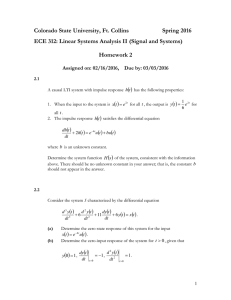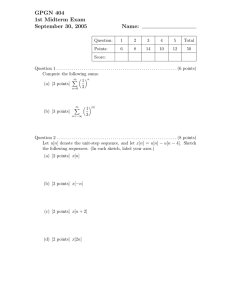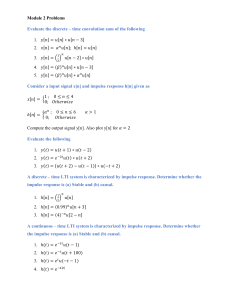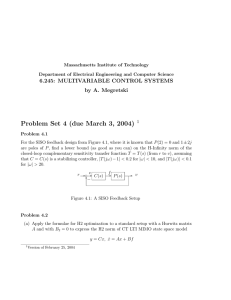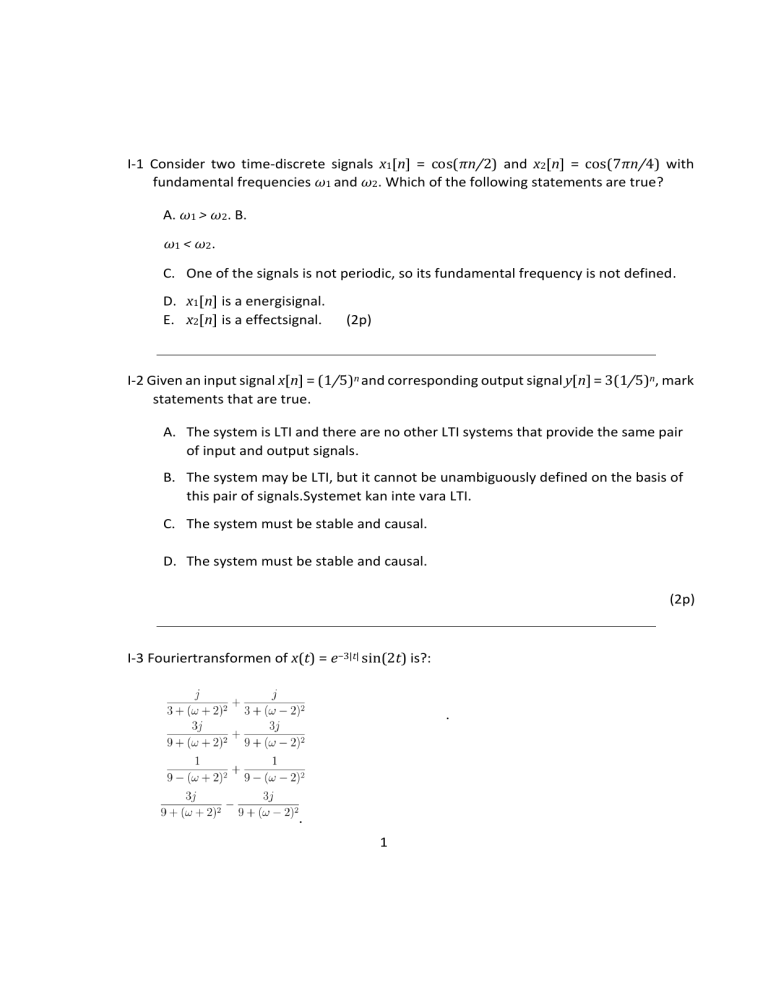
I-1 Consider two time-discrete signals x1[n] = cos(πn/2) and x2[n] = cos(7πn/4) with fundamental frequencies ω1 and ω2. Which of the following statements are true? A. ω1 > ω2. B. ω1 < ω2. C. One of the signals is not periodic, so its fundamental frequency is not defined. D. x1[n] is a energisignal. E. x2[n] is a effectsignal. (2p) I-2 Given an input signal x[n] = (1/5)n and corresponding output signal y[n] = 3(1/5)n, mark statements that are true. A. The system is LTI and there are no other LTI systems that provide the same pair of input and output signals. B. The system may be LTI, but it cannot be unambiguously defined on the basis of this pair of signals.Systemet kan inte vara LTI. C. The system must be stable and causal. D. The system must be stable and causal. (2p) I-3 Fouriertransformen of x(t) = e−3|t| sin(2t) is?: . . 1 (2p) I-4 Which of the following transmission functions can come from causal time-discrete LTI systems? A. . B. . C. . D. . (2p) I-5 Which of the following pairs of input signals x and output signals y are possible for a stable and causal LTI system? A. x(t) = etu(t) and y(t) = e2tu(t + 1). B. x(t) = sin(2t) and y(t) = 3j cos(2t) C. and y(t) = (1 + 2t2)u(t). D. x(t) = ej2t and y(t) = cos(2t). E. x(t) = δ(t) and y(t) = −2δ(t) + e−2tu(t). (2p) I-6 We know that a signal x (t) can be written as a sum of an even signal xe (t) and an odd signal xo (t). Which of the following signals represents the even sub-signal to x (t) (shown in the figure below)? A. Signal A. D. Signal D. B. Signal B. C. Signal C. E. None of A-D. 2 (1p) I-7 Given an LTI system. Assume that the impulse response is the step function h(t) = u(t) and the input signal is the ramp function true for the output signal y = x * h . Which statements are A. y(t) is a rampfunktion. B. y(t) is a rektanglepulse. C. y(t) is a triangelpulse. D. None of the above options. (2p) 3 I-8 In the course we talked about four common filters: low-pass, high-pass, bandpass and band-stop filters. In Figure 1, some filters are described with pole and zero positions in the z-plane (Figure A-D). Note that "o" marks zeros while "x" marks poles, and that all filters are 4th order filters. Specify which pole and zero position corresponds to which filter. It takes at least two specified pairs to get a point. (2p) Part II II-1 Consider an LTI system with the step response s(t) = (e−3t − 2e−2t + 1)u(t). (a) Determine the impulse response. (2p) (b) What will be the output signal if the input signal is x(t) = etu(t)? 4 (2p) II-2 (a) Is the system y[n] = x[n2 − 1] linear / time invariant / stable / causal? Motivate for each answer (prove or give a counterexample). II-3 (a) Determine a 2π-periodic solution to the equation y0(t)+2y(t−π) = sint. Hint: Use Fourierseries. (b) Determine the effect (average energy) for the signal y(t) i (a). (4p) (2p) II-4 Let q(t) = te−αtu(t), α ∈ R. Consider a causal LTI system y = x ∗ h such that y(t) = (q ∗ x)(t) − (q ∗ y)(t). (a) Determine the system function H(s). (2p) (b) For which α is the system stable? Motivate. (c) Determine the impulse response h(t). (2p) (2p) II-5A so-called Notch filter with the sampling frequency18 kHz has transfer function (a) What frequency is extinguished by the filter? Suppose we work with real input signals. (2p) (b) Determine a difference equation that describes the filter. (2p) (c) If we were to design an analog Notch filter that turns off the same frequency, what would a pole reset diagram look like? A clear justification is required. (2p) II-6 (a) It is known that DFT can be used to analyze the frequency content of a variety of different types of signals. In this task, the DFT was calculated from three different, periodic time-discrete signals. The time discrete signals are shown in Figure a) while the amount of their transformers is shown in Figure b). If figure b) had shown the complete transforms, we could easily have seen which transform corresponds to which time signal because they 5 have different lengths, 180, 150 respectively 120. Unfortunately, we only have the first 30 points at hand, which creates some uncertainty about which signal corresponds to which transform. Your task is to pair the signals x1[n], x2[n] and x3[n] with their respective transformer XA[k], XB[k] or XC[k]. A clear justification is required. (5p) (b) (b) A time-continuous signal x(t) = 4cos(300t) was sampled and its 64 points DFT whose absolute amount is shown in Figure 2 is calculated. Decide the frequency of the discrete signal Ω0. (3p) (c) Determine the sampling frequency Fs Hz used to sample the signal in task II-7b. Assume that no folding has occurred. (1p) An illustration of the periodic signals that were generated in the task II-6a The first 30 DFT points of the three DFTs that were calculated in the task II-6a 6 The absolute amount of the DFT in Task II-6 (b). 7
